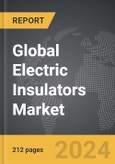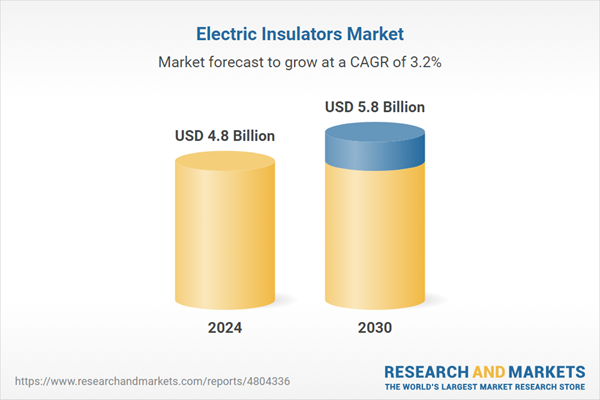The global market for Electric Insulators was valued at US$4.8 Billion in 2024 and is projected to reach US$5.8 Billion by 2030, growing at a CAGR of 3.2% from 2024 to 2030. This comprehensive report provides an in-depth analysis of market trends, drivers, and forecasts, helping you make informed business decisions. The report includes the most recent global tariff developments and how they impact the Electric Insulators market.
Segments: Segment (Ceramic, Composites, Glass); End-Use (Utilities, Industrial, Other End-Uses).
Geographic Regions/Countries: World; United States; Canada; Japan; China; Europe (France; Germany; Italy; United Kingdom; Spain; Russia; and Rest of Europe); Asia-Pacific (Australia; India; South Korea; and Rest of Asia-Pacific); Latin America (Argentina; Brazil; Mexico; and Rest of Latin America); Middle East (Iran; Israel; Saudi Arabia; United Arab Emirates; and Rest of Middle East); and Africa.
The analysts continuously track trade developments worldwide, drawing insights from leading global economists and over 200 industry and policy institutions, including think tanks, trade organizations, and national economic advisory bodies. This intelligence is integrated into forecasting models to provide timely, data-driven analysis of emerging risks and opportunities.
Global Electric Insulators Market - Key Trends and Drivers Summarized
Why Are Electric Insulators Critical to the Infrastructure of Modern Energy Systems?
Electric insulators play a pivotal role in the safe and efficient operation of electrical systems, serving as a barrier between electrical conductors and the earth or other conductive materials. These insulators prevent the unwanted flow of current and ensure that electrical devices and power systems operate at optimal safety levels. Insulators are made from materials such as porcelain, glass, rubber, and various polymers, each chosen for specific environments and applications. The reliability of power transmission and distribution networks heavily depends on the quality and condition of these insulators. Over time, the design and materials used in electric insulators have evolved to meet the increasing demands for higher voltages and more challenging environmental conditions. This evolution is crucial in areas exposed to extreme weather, pollution, and mechanical stresses, where traditional materials might fail. Innovations in material science have led to the development of composite insulators that offer superior performance, including enhanced durability and reduced maintenance needs.How Are Technological Advancements Transforming the Electric Insulator Industry?
The electric insulator industry is undergoing significant transformation due to technological advancements and the integration of smart technologies. The introduction of smart insulators equipped with sensors allows real-time monitoring of their condition and performance. This capability is vital for preventing failures and optimizing maintenance schedules, thereby reducing downtime and operational costs. Smart sensors embedded in insulators can detect early signs of degradation such as cracks, erosion, or contamination, which can compromise the insulator's effectiveness and lead to power outages or safety hazards. Furthermore, advancements in materials technology have led to the creation of more robust and environmentally resistant insulators. For instance, silicone-based composite insulators are increasingly favored over traditional ceramic or glass types due to their improved performance in adverse conditions and their resilience to vandalism or ballistic damage. These innovations enhance the reliability of the power grid and contribute to the overall stability of electrical infrastructure.What Impact Do Electric Insulators Have on Environmental and Regulatory Compliance?
Compliance with environmental and safety regulations is a significant concern for the electric power industry, and electric insulators are at the heart of these compliance efforts. Effective insulation helps prevent the leakage and wastage of electricity, which not only enhances the efficiency of power distribution but also minimizes the environmental impact associated with energy loss. Electrical insulators reduce the incidence of power surges and arcs, which can lead to fires and other hazardous conditions. Regulatory bodies worldwide impose stringent standards on the insulation materials and designs to ensure they can withstand the operational stresses while safeguarding the environment and public health. Moreover, the shift toward greener and more sustainable materials in the production of electric insulators reflects the industry’s response to increasing environmental concerns. These materials are designed to be less pollutive and more recyclable, aligning with global efforts to reduce the carbon footprint of industrial products.What Drives Growth in the Electric Insulator Market?
The growth in the electric insulator market is driven by several factors, including the global expansion of power generation and distribution networks, technological innovations, and heightened environmental awareness. As the world increasingly turns towards renewable energy sources, the demand for high-performance insulators for use in harsh and variable environments has surged. The growth is further fueled by the need to upgrade aging electrical infrastructure, particularly in developed countries, where much of the power grid may be decades old and in need of modernization to handle increased loads and efficiency requirements. Additionally, regulatory changes mandating higher performance standards for electrical components have stimulated the development of more advanced insulating materials. Emerging markets are also significant contributors to this growth, as rapid urbanization and industrialization increase the demand for reliable and efficient electrical infrastructure. Lastly, consumer trends towards more energy-efficient systems and the integration of smart grid technologies are creating new opportunities for innovation and expansion within the electric insulator industry.Report Scope
The report analyzes the Electric Insulators market, presented in terms of units. The analysis covers the key segments and geographic regions outlined below.Segments: Segment (Ceramic, Composites, Glass); End-Use (Utilities, Industrial, Other End-Uses).
Geographic Regions/Countries: World; United States; Canada; Japan; China; Europe (France; Germany; Italy; United Kingdom; Spain; Russia; and Rest of Europe); Asia-Pacific (Australia; India; South Korea; and Rest of Asia-Pacific); Latin America (Argentina; Brazil; Mexico; and Rest of Latin America); Middle East (Iran; Israel; Saudi Arabia; United Arab Emirates; and Rest of Middle East); and Africa.
Key Insights:
- Market Growth: Understand the significant growth trajectory of the Ceramic Insulators segment, which is expected to reach US$3.0 Billion by 2030 with a CAGR of a 4.1%. The Composite Insulators segment is also set to grow at 2.3% CAGR over the analysis period.
- Regional Analysis: Gain insights into the U.S. market, valued at $1.3 Billion in 2024, and China, forecasted to grow at an impressive 5.9% CAGR to reach $1.2 Billion by 2030. Discover growth trends in other key regions, including Japan, Canada, Germany, and the Asia-Pacific.
Why You Should Buy This Report:
- Detailed Market Analysis: Access a thorough analysis of the Global Electric Insulators Market, covering all major geographic regions and market segments.
- Competitive Insights: Get an overview of the competitive landscape, including the market presence of major players across different geographies.
- Future Trends and Drivers: Understand the key trends and drivers shaping the future of the Global Electric Insulators Market.
- Actionable Insights: Benefit from actionable insights that can help you identify new revenue opportunities and make strategic business decisions.
Key Questions Answered:
- How is the Global Electric Insulators Market expected to evolve by 2030?
- What are the main drivers and restraints affecting the market?
- Which market segments will grow the most over the forecast period?
- How will market shares for different regions and segments change by 2030?
- Who are the leading players in the market, and what are their prospects?
Report Features:
- Comprehensive Market Data: Independent analysis of annual sales and market forecasts in US$ Million from 2024 to 2030.
- In-Depth Regional Analysis: Detailed insights into key markets, including the U.S., China, Japan, Canada, Europe, Asia-Pacific, Latin America, Middle East, and Africa.
- Company Profiles: Coverage of players such as ABB Group, Bharat Heavy Electricals Ltd., KREMPEL GmbH, MacLean-Fogg Company, NGK Insulators Ltd. and more.
- Complimentary Updates: Receive free report updates for one year to keep you informed of the latest market developments.
Some of the 19 companies featured in this Electric Insulators market report include:
- ABB Group
- Bharat Heavy Electricals Ltd.
- KREMPEL GmbH
- MacLean-Fogg Company
- NGK Insulators Ltd.
- PFISTERER Holding AG
- Siemens Energy
- Toshiba Corporation
- WT Henley
Tariff Impact Analysis: Key Insights for 2025
Global tariff negotiations across 180+ countries are reshaping supply chains, costs, and competitiveness. This report reflects the latest developments as of April 2025 and incorporates forward-looking insights into the market outlook.The analysts continuously track trade developments worldwide, drawing insights from leading global economists and over 200 industry and policy institutions, including think tanks, trade organizations, and national economic advisory bodies. This intelligence is integrated into forecasting models to provide timely, data-driven analysis of emerging risks and opportunities.
What’s Included in This Edition:
- Tariff-adjusted market forecasts by region and segment
- Analysis of cost and supply chain implications by sourcing and trade exposure
- Strategic insights into geographic shifts
Buyers receive a free July 2025 update with:
- Finalized tariff impacts and new trade agreement effects
- Updated projections reflecting global sourcing and cost shifts
- Expanded country-specific coverage across the industry
Table of Contents
I. METHODOLOGYII. EXECUTIVE SUMMARY2. FOCUS ON SELECT PLAYERSIII. MARKET ANALYSISSOUTH KOREAREST OF ASIA-PACIFICARGENTINABRAZILMEXICOREST OF LATIN AMERICAIRANISRAELSAUDI ARABIAUNITED ARAB EMIRATESREST OF MIDDLE EASTIV. COMPETITION
1. MARKET OVERVIEW
3. MARKET TRENDS & DRIVERS
4. GLOBAL MARKET PERSPECTIVE
UNITED STATES
CANADA
JAPAN
CHINA
EUROPE
FRANCE
GERMANY
ITALY
UNITED KINGDOM
SPAIN
RUSSIA
REST OF EUROPE
ASIA-PACIFIC
AUSTRALIA
INDIA
LATIN AMERICA
MIDDLE EAST
AFRICA
Companies Mentioned (Partial List)
A selection of companies mentioned in this report includes, but is not limited to:
- ABB Group
- Bharat Heavy Electricals Ltd.
- KREMPEL GmbH
- MacLean-Fogg Company
- NGK Insulators Ltd.
- PFISTERER Holding AG
- Siemens Energy
- Toshiba Corporation
- WT Henley
Table Information
| Report Attribute | Details |
|---|---|
| No. of Pages | 212 |
| Published | April 2025 |
| Forecast Period | 2024 - 2030 |
| Estimated Market Value ( USD | $ 4.8 Billion |
| Forecasted Market Value ( USD | $ 5.8 Billion |
| Compound Annual Growth Rate | 3.2% |
| Regions Covered | Global |









